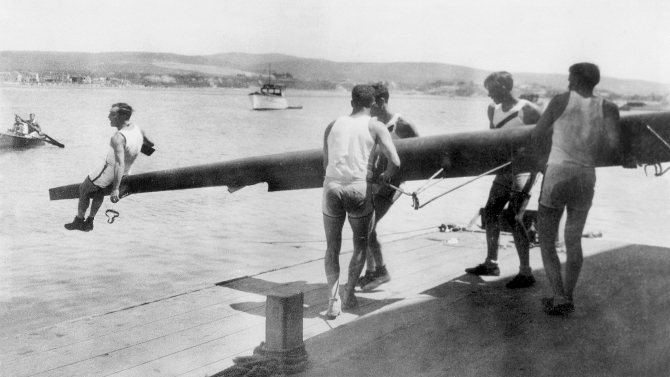Showing off his immense skills in a rather unusual way, Buster Keaton heads to College in this 1927 feature that followed up The General; a Civil War set picture that is now known as a classic (and often considered his masterpiece), its expansive story bloated the budget and somehow brought lackluster reviews, leading to a rare bust at the box office.
So, his next film (the above mentioned College) was designed to be more commercially viable and Keaton was reeled in, forced to be under the thumb of co-director James W. Horne (who according to Keaton, did virtually nothing) as well as producer Harry Brand (publicity chief for Keaton’s usual producer Joseph Schenck – he had just become president of United Artists), the latter constantly scrutinized every penny Keaton spent, making sure he didn’t go over budget like with The General. Further annoying the funnyman, the producer made sure that he received a “Supervised by Harry Brand” credit on the film.
Receiving another batch of ungracious reviews, it was Keaton’s second bomb in a row. Despite that, College, like The General, is considered by most today to be a classic (though more of a middling effort compared to some of his other motion pictures).
The story follows Ronald (Keaton), an impoverished bookworm who is valedictorian of his high school (and in his speech, insults every athlete along the way), and is head over heels in love with the most popular girl in school, Mary Haynes (Anne Cornwall). Wholly insulted by his address, she shrugs him off, discouraged by his outlook on athletics. Mary instead turns to the star athlete of the school, Jeff (Harold Goodwyn) – it took him seven years to graduate.
Deciding that he will work and go to college at the same time (the only way he will ever be able to go to university), Ronald turns his outlook to sports, ignoring his studies to impress the girl. It is rather humorous that Keaton, one of the most athletic actors of all-time, puts all of his skills into looking utterly lost in everything his tries. A talent on the baseball diamond, he was known to start impromptu games on set when his creative juices stalled. . . yet, in College, you’d never know it. A pitiful third baseman and batter, his slide home is neck-crackingly amazing. . . though it most definitely does not help him make the team.
Mixing his flailing athletics with jobs as both a soda jerk and a black waiter (not exactly politically correct by today’s standards), he fails miserably – though he tries to match the star employee’s skills at the malt shop. Eventually getting the chance to be the coxswain on the rowing team thanks to the Dean (Snitz Edwards) – he too loved and lost, it is Ronald’s chance to shine, wooing Mary – who is becoming increasingly disenchanted with her jock of a beau. Will Ronald win the race and get the girl?
Not so much a fluid story as a number of comedic vignettes, many of the best moments come when Buster tries his hand at track and field. Placing the camera in the opportune place to capture the gags, the javelin toss and hurdles are perfect examples of these clumsy conquests. Cleverly though, everything he learned earlier in the film comes together in his final quest. It is in this closing action set piece that one of Keaton’s only stunts he didn’t perform himself can be found – having to high jump into a room. Instead of taking the time to learn the arduous task, he hired 1924 Olympic gold medalist Lee Barnes for the job.
For better or worse, College is often compared to Harold Lloyd’s 1925 The Freshman, though both are enjoyable in their own right. With Keaton building wonderful and highly comic set pieces that will appeal to the sports enthusiasts in all of us, there is a lot of fun to be had here. So, avoid any grave subject matter and marry this picture into your comedy collection in its ninetieth year, it is still worth chasing down.

